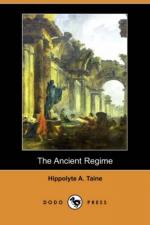“Behold the civilized man; here is the savage man!”
At this line the applause breaks forth, and the success of the piece is such that it is demanded at Versailles and played before the court.
The same ideas have to be expressed with skill, brilliancy, gaiety, energy and scandal, and this is accomplished in “The Marriage of Figaro.” Never were the ideals of the age displayed under a more transparent disguise, nor in an attire that rendered them more attractive. Its title is the " Folle journee,” and indeed it is an evening of folly, an after-supper like those occurring in the fashionable world, a masquerade of Frenchmen in Spanish costumes, with a parade of dresses, changing scenes, couplets, a ballet, a singing and dancing village, a medley of odd characters, gentlemen, servants, duennas, judges, notaries, lawyers, music-masters, gardeners, pastoureaux; in short, a spectacle for the eyes and the ears, for all the senses, the very opposite of the prevailing drama in which three pasteboard characters, seated on classic chairs, exchange didactic arguments in an abstract saloon. And still better, it is an imbroglio displaying a superabundance of action, amidst intrigues that cross, interrupt and renew each other, through a pêle-mêle of travesties, exposures, surprises, mistakes, leaps from windows, quarrels and slaps, and all in sparkling style, each phrase flashing on all sides, where responses seem to be cut out by a lapidary, where the eyes would forget themselves in contemplating the multiplied brilliants of the dialogue if the mind were not carried along by its rapidity and the excitement of the action. But here is another charm, the most welcome of all in a society passionately fond of Parny; according to an expression of the Comte d’Artois, which I dare not quote, this appeals to the senses, the arousing of which constitutes the spiciness and savor of the piece. The fruit that hangs ripening and savory on the branch never falls but always seems on the point of falling; all hands are extended to catch it, its voluptuousness somewhat veiled but so much the more provoking, declaring itself from scene to scene, in the Count’s gallantry, in the Countess’s agitation, in the simplicity




